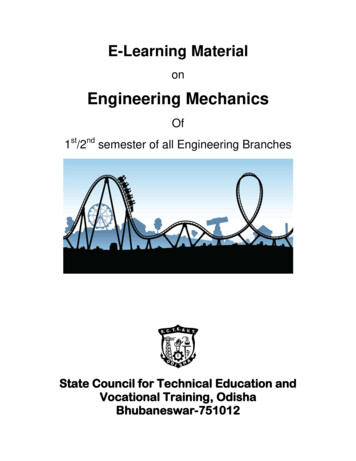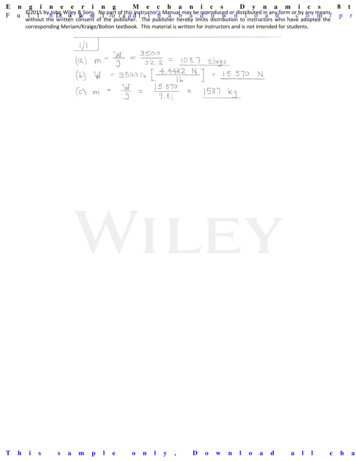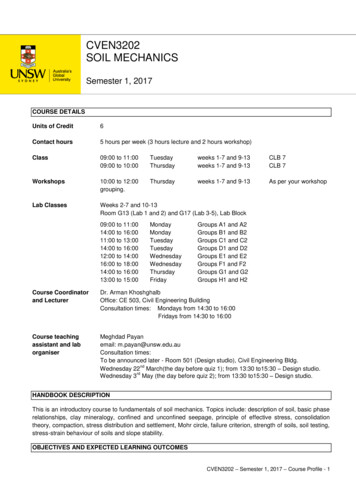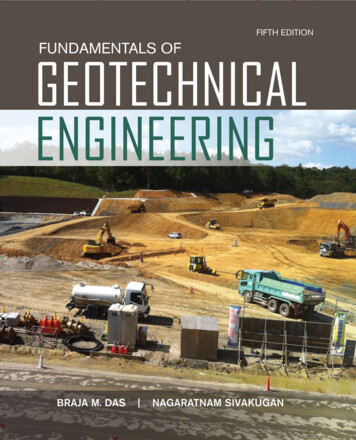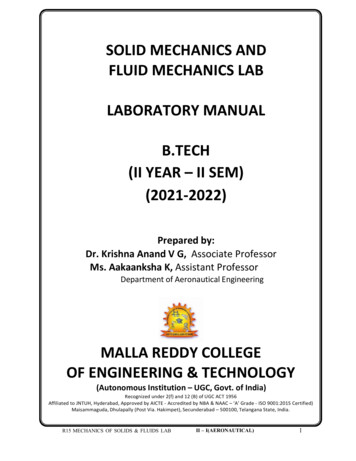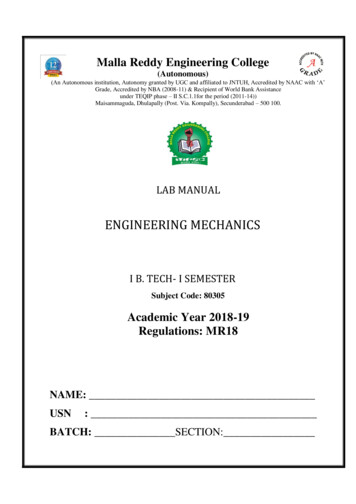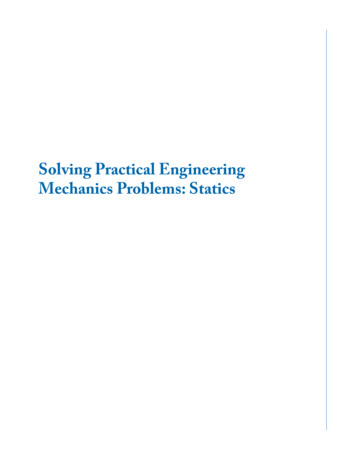
Transcription
Solving Practical EngineeringMechanics Problems: Statics
iiiSynthesis Lectures onMechanical EngineeringSynthesis Lectures on Mechanical Engineering series publishes 60–150 page publications pertaining to this diversediscipline of mechanical engineering. The series presents Lectures written for an audience of researchers, industryengineers, undergraduate and graduate students. Additional Synthesis series will be developed covering key areaswithin mechanical engineering.Solving Practical Engineering Mechanics Problems: StaticsSayavur I. BakhtiyarovOctober 2017Resistance Spot Welding: Fundamentals and Applications for the Automotive IndustryMenachem Kimchi and David H. PhillipsOctober 2017Unmanned Aircraft Design: Review of FundamentalsMohammad SadraeySeptember 2017Introduction to Refrigeration and Air Conditioning Systems: Theory and ApplicationsAllan KirkpatrickSeptember 2017MEMS Barometers Toward Vertical Position Detection: Background Theory, System Prototyping, and Measurement AnalysisDimosthenis E. BolanakisMay 2017Vehicle Suspension System Technology and DesignAvesta Goodarzi, Amir KhajepourMay 2017Engineering Finite Element AnalysisRamana M. PidapartiMay 2017
Copyright 2018 by Morgan & ClaypoolAll rights reserved. No part of this publication may be reproduced, stored in a retrieval system, or transmitted inany form or by any means—electronic, mechanical, photocopy, recording, or any other except for brief quotations in printed reviews,without the prior permission of the publisher.Solving Practical Engineering Mechanics Problems: StaticsSayavur I. Bakhtiyarovwww.morganclaypool.comISBN: 9781681731889 printISBN: 9781681731896 ebookDOI 10.2200/S00799ED1V01Y201709MEC008A Publication in the Morgan & Claypool Publishers seriesSYNTHESIS LECTURES ON MECHANICAL ENGINEERING, #8Series ISSN: 2573-3168 Print 2573-3176 Electronic
Solving Practical EngineeringMechanics Problems: StaticsSayavur I. BakhtiyarovNew Mexico Institute of Mining and TechnologySYNTHESIS LECTURES ON MECHANICAL ENGINEERING #8M&CMORGAN& CLAYPOOL PUBLISHERS
viABSTRACTEngineering mechanics is one of the fundamental branches of science that is important in the education of professional engineers of any major. Most of the basic engineering courses, such as mechanics of materials, fluid and gasmechanics, machine design, mechatronics, acoustics, vibrations, etc. are based on engineering mechanics courses. Inorder to absorb the materials of engineering mechanics, it is not enough to consume just theoretical laws and theorems—a student also must develop an ability to solve practical problems. Therefore, it is necessary to solve manyproblems independently. This book is a part of a four-book series designed to supplement the engineering mechanicscourses. This series instructs and applies the principles required to solve practical engineering problems in the following branches of mechanics: statics, kinematics, dynamics, and advanced kinetics. Each book contains between 6 and 8topics on its specific branch and each topic features 30 problems to be assigned as homework, tests, and/or midterm/final exams with the consent of the instructor. A solution of one similar sample problem from each topic is provided.This first book contains seven topics of statics, the branch of mechanics concerned with the analysis of forcesacting on construction systems without an acceleration (a state of the static equilibrium). The book targets the undergraduate students of the sophomore/junior level majoring in science and engineering. The author welcomes allfeedback/comments from the reader. Please feel free to contact him at sayavur.bakhtiyarov@nmt.edu.KEYWORDSforce, moment, torque, gravity, equilibrium, center of gravity
viiContentsAcknowledgments. . . . . . . . . . . . . . . . . . . . . . . . . . . . . . . . . . . . . . . . . . . . . . . . . . . . ix1Topic S-1 . . . . . . . . . . . . . . . . . . . . . . . . . . . . . . . . . . . . . . . . . . . . . . . . . . . . . . . . . . . 11.1 Determination of the Reaction Forces of Supports for Rigid Body 11.2 Sample Problem . . . . . . . . . . . . . . . . . . . . . . . . . . . . . . . . . . . . . . . . . . . . . . . . . . . . . . . . . . . . . 151.3 Solution . . . . . . . . . . . . . . . . . . . . . . . . . . . . . . . . . . . . . . . . . . . . . . . . . . . . . . . . . . . . . . . . . . . 162Topic S-2 . . . . . . . . . . . . . . . . . . . . . . . . . . . . . . . . . . . . . . . . . . . . . . . . . . . . . . . . . . . 192.1 Application of the Method of Joints to Find Unknown Forces in a Plane (2D)Truss Structure . . . . . . . . . . . . . . . . . . . . . . . . . . . . . . . . . . . . . . . . . . . . . . . . . . . . . . . . . . . . . . 192.2 Sample Problem . . . . . . . . . . . . . . . . . . . . . . . . . . . . . . . . . . . . . . . . . . . . . . . . . . . . . . . . . . . . . 322.3 Solution . . . . . . . . . . . . . . . . . . . . . . . . . . . . . . . . . . . . . . . . . . . . . . . . . . . . . . . . . . . . . . . . . . . 322.3.1 Determining Reaction Forces by Analytical Method 322.3.2 Determining the Forces in the Truss Members 333Topic S-3 . . . . . . . . . . . . . . . . . . . . . . . . . . . . . . . . . . . . . . . . . . . . . . . . . . . . . . . . . . . 373.1 Determination of Reaction Forces of Supports for Composite Stud 373.2 Sample Problem . . . . . . . . . . . . . . . . . . . . . . . . . . . . . . . . . . . . . . . . . . . . . . . . . . . . . . . . . . . . . 453.3 Solution . . . . . . . . . . . . . . . . . . . . . . . . . . . . . . . . . . . . . . . . . . . . . . . . . . . . . . . . . . . . . . . . . . . 454Topic S-4 . . . . . . . . . . . . . . . . . . . . . . . . . . . . . . . . . . . . . . . . . . . . . . . . . . . . . . . . . . . 494.1 Determination of Reaction Forces of Supports for Composite Construction(System of Two Bodies) . . . . . . . . . . . . . . . . . . . . . . . . . . . . . . . . . . . . . . . . . . . . . . . . . . . . . . . 494.2 Sample Problem . . . . . . . . . . . . . . . . . . . . . . . . . . . . . . . . . . . . . . . . . . . . . . . . . . . . . . . . . . . . . 624.3 Solution . . . . . . . . . . . . . . . . . . . . . . . . . . . . . . . . . . . . . . . . . . . . . . . . . . . . . . . . . . . . . . . . . . . 625Topic S-5 . . . . . . . . . . . . . . . . . . . . . . . . . . . . . . . . . . . . . . . . . . . . . . . . . . . . . . . . . . . 675.1 Determination of Reaction Forces of Supports for Composite Construction(System of Three Bodies) . . . . . . . . . . . . . . . . . . . . . . . . . . . . . . . . . . . . . . . . . . . . . . . . . . . . . . 675.2 Sample Problem . . . . . . . . . . . . . . . . . . . . . . . . . . . . . . . . . . . . . . . . . . . . . . . . . . . . . . . . . . . . . 815.3 Solution . . . . . . . . . . . . . . . . . . . . . . . . . . . . . . . . . . . . . . . . . . . . . . . . . . . . . . . . . . . . . . . . . . . 816Topic S-6 . . . . . . . . . . . . . . . . . . . . . . . . . . . . . . . . . . . . . . . . . . . . . . . . . . . . . . . . . . . 856.1 Determination of reaction forces of rods supporting rectangular plate 856.2 Sample Problem . . . . . . . . . . . . . . . . . . . . . . . . . . . . . . . . . . . . . . . . . . . . . . . . . . . . . . . . . . . . 1006.3 Solution . . . . . . . . . . . . . . . . . . . . . . . . . . . . . . . . . . . . . . . . . . . . . . . . . . . . . . . . . . . . . . . . . . 1017Topic S-7 . . . . . . . . . . . . . . . . . . . . . . . . . . . . . . . . . . . . . . . . . . . . . . . . . . . . . . . . . . . 1057.1 Determination of Center of Gravity . . . . . . . . . . . . . . . . . . . . . . . . . . . . . . . . . . . . . . . . . . . . 1057.2 Sample Problem . . . . . . . . . . . . . . . . . . . . . . . . . . . . . . . . . . . . . . . . . . . . . . . . . . . . . . . . . . . . 1217.3 Solution . . . . . . . . . . . . . . . . . . . . . . . . . . . . . . . . . . . . . . . . . . . . . . . . . . . . . . . . . . . . . . . . . . 122Author Biography . . . . . . . . . . . . . . . . . . . . . . . . . . . . . . . . . . . . . . . . . . . . . . . . . . . . 125
ixAcknowledgmentsThe author acknowledges that this work is essentially a translation and a revision of selected problems providedby Professor A. A. Yablonski (Collection of Problems for Course Projects in Theoretical Mechanics, 2nd ed., VischayaShkola Publishers, 1972, in Russian). The author intended to introduce this unique work to western academia,which is the product of material covered by him in many classes over a period of four decades in a number ofuniversities and colleges.
1CHAPTER1Topic S-11.1DETERMINATION OF THE REACTION FORCES OF SUPPORTS FORRIGID BODYFind reaction forces in supports of the given construction systems schematically shown in Figures 1.1‒1.30. The sizesare in meters and the loads are shown in the table below.Problem 10510410810761416410610MkN m201058745649786104108678107201487814qkN 453045301530
21. PROBLEM S-1qαABMGP22Figure 1.1.CPαqαDMABG2Figure 1.2.13
1.1 DETERMINATION OF THE REACTION FORCES OF SUPPORTS FOR RIGID BODYPqαABMG22Figure 1.3.123ABMqGFigure 1.4.α3
41. PROBLEM S-1A4MCBp2αqDFigure 1.5.Pqα32MAFigure 1.6.1B
1.1 DETERMINATION OF THE REACTION FORCES OF SUPPORTS FOR RIGID BODY2BαP2qαMAFigure 1.7.4P13αDAFigure 1.8.MEFqGBαC5
61. PROBLEM S-1112qBAMααGPFigure 1.9.11qPMBEAαC21.5G2.52αDFigure 1.10.B2αMqαAFigure 1.11.43P
1.1 DETERMINATION OF THE REACTION FORCES OF SUPPORTS FOR RIGID BODYCBPGMαAFigure 1.12.PFDαqMα1C11GFigure 1.13.ABF1E7
1. PROBLEM S-1q13M1A2αGPFigure 1.14.12qGα48MAFigure 1.15.P
1.1 DETERMINATION OF THE REACTION FORCES OF SUPPORTS FOR RIGID BODYqP222GABFigure 1.16.4P1.52αBqGAFigure 1.17.αPAFigure 1.18.αGMGαBα9
101. PROBLEM S-1A1Mq22qB3αPFigure 1.19.2qM3AFigure 1.20.αB4αPC
1.1 DETERMINATION OF THE REACTION FORCES OF SUPPORTS FOR RIGID BODYMPα24q4ABαFigure 1.21.αPM2ABαFigure 1.22.22q11
121. PROBLEM S-1PMBqαA2Figure 1.23.3MBP2α2αqAFigure 1.24.C
1.1 DETERMINATION OF THE REACTION FORCES OF SUPPORTS FOR RIGID BODYqPαB222MAFigure 1.25.2qPα3B23AM2Figure 1.26.2q13
141. PROBLEM S-1Figure 1.27.A2MqB2PFigure 1.28.α2
1.2 SAMPLE PROBLEM2qMα212α PBαAFigure 1.29.PBαMAαGFigure 1.30.1.2SAMPLE PROBLEMDefine the reaction forces in support A and rod CD of the construction schematically shown in Figure 1.31.G 10 kN; P 5 kN; M 8 kN m; q 0.5 kN/m; a 30 . The sizes are in meters.15
161. PROBLEM S-1DqP21MCαA1B2GFigure 1.31.1.3SOLUTIONLet’s consider the equilibrium of the forces applied to the stud AB. Remove the supports: pin support at the point A,the member CD, and the string attached to point B. The actions of the support are replaced by the appropriate reaction forces (Figure 1.32). Because the direction of the reaction force of the pin A is unknown, we need to determineits components XA and YA. We also show the reaction SCD in member CD and the reaction S in the string, which isby magnitude equal to P. Evenly distributed load of the intensity q is replaced by the concentrated force Q, which isequal: Q 2 q 2 0.5 1 kN and applied in the center of gravity of the distributed forces.y90 YAACαXA1Figure 1.32.SCDQMBG2S12x
1.3 SOLUTION17Three equilibrium equations can be written for the plane (2D) system of forces applied to the system: MiA 0; ‒Q 1 ‒ G 3 SCD 4 sin 30 ‒ M S 6 0(1.1) Yi YA ‒ Q ‒ G SCD cos 60 S 0(1.3) Xi 0;XA ‒ SCD cos 30 0(1.2)From Equation (1.1):SCD Q 1 G 3 M ‒ S 6 1 1 10 3 8 ‒ 5 6 4.5 kN.4 sin 30 4 0.5From Equation (1.2):XA SCD cos 30 4.5 0.866 3.90 kN.From Equation (1.3):YA Q G ‒ SCD cos 60 ‒ S 1 10 ‒ 4.5 0.5 ‒ 5 3.75 kN.The values of XA, YA, and SCD are positive. It means the assumed directions of these forces coincide with their truedirections.
Engineering mechanics is one of the fundamental branches of science that is important in the education of profes-sional engineers of any major. Most of the basic engineering courses, such as mechanics of materials, fluid and gas mechanics, machine design, mechatronics, acoustics, vibrations, etc. are based on engineering mechanics courses. In

